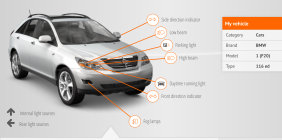µAFS LED headlights
New automotive lighting revolutionizes road safety
What is the course of the road, how fast is the car driving, is there oncoming traffic, and what is the distance between the car and other vehicles? In a research project over the past three years, a smart, high resolution headlight has been created, that already analyzes driving and weather conditions continuously. This takes adaptive forward lighting to a new dimension.
As overall manager and part of a research alliance, OSRAM has successfully completed the development of the basis for smart, high resolution LED headlights. The demonstration model was developed in collaboration with the project partners Daimler, Fraunhofer, Hella and Infineon, and was co-funded by the German Federal Ministry of Education and Research (BMBF).
Individually adaptable smart pixel headlights for optimum light conditions
Both headlights contain three LED light sources, each with 1,024 individually controllable light points (pixels). This means that the headlight can be adapted very precisely to suit the respective traffic situation to ensure optimum light conditions at all times without dazzling other drivers.
The light can be adapted to take account of every conceivable bend in the road so that there are no dark peripheral areas. In addition, with the aid of sensors in the vehicle, the surroundings can be analyzed in order to illuminate oncoming traffic. This allows the driver to see these vehicles more clearly. At the same time, the beam of light does not shine on the heads of oncoming drivers, which means they’re not dazzled. As a result, such shifting headlights no longer have to be dimmed on country roads.
Same size of headlights, more resolution
In the current generation of adaptive headlights on the market, several LED components are installed in the headlights side by side and on top of each other. Additional electronic components are required to switch light segments on and off.
The number of segments is limited due to the restricted space in the headlight. In the new approach, electronic activation of the LED is integrated in the chip, resulting in a much higher resolution, while still meeting limited space requirements. The LED module features an electrical and thermal interface that enables direct connection to the vehicle’s electronics.
Close-up of a µAFS LED matrix headlight
Tailor-made, smart lighting for every condition
Bright high beam
High beam: anti-glare mode activated
Benefits of the innovation
At high speeds, the range of the light beam is increased automatically. In city traffic, on the other hand, wider light distribution improves safety as, in addition to the road, also the sidewalk and peripheral areas are illuminated better. These functions are implemented fully electronically with no mechanical actuators. With glare-free full beam the driver always has the best possible light at night – with no adverse effects for other drivers. For motorists this is a clear benefit in terms of awareness and an important contribution towards reducing the risk of accidents when driving at night.
Press release: New automotive lighting revolutionizes road safetyThe new adaptive headlights can prevent glare for other road users while the surroundings remain illuminated
The new LED chip with 1,024 individually controllable light points (pixels) is around as large as a fingernail.
The combination of three such chips allows a resolution of 3,072 pixels per headlight.

















